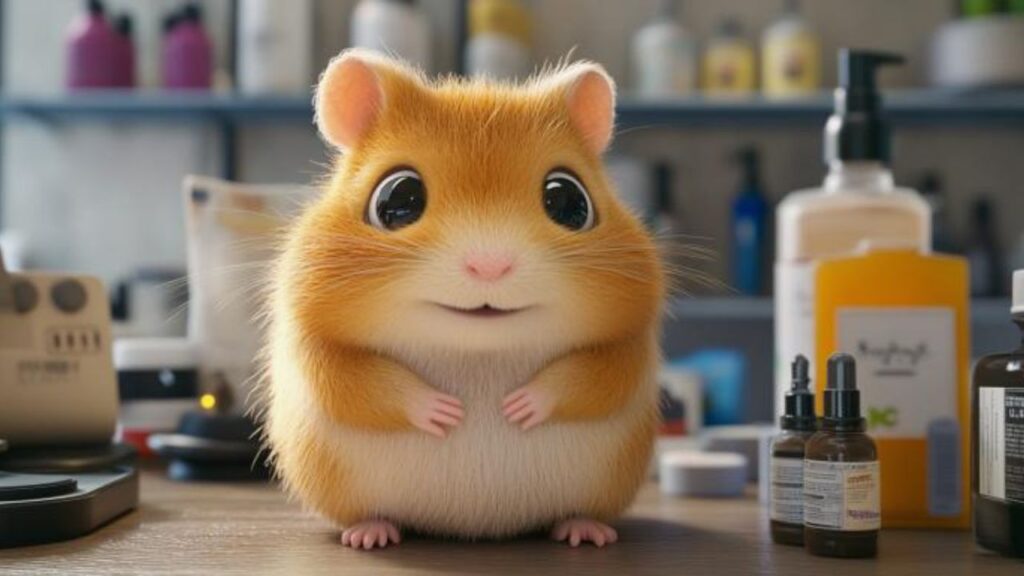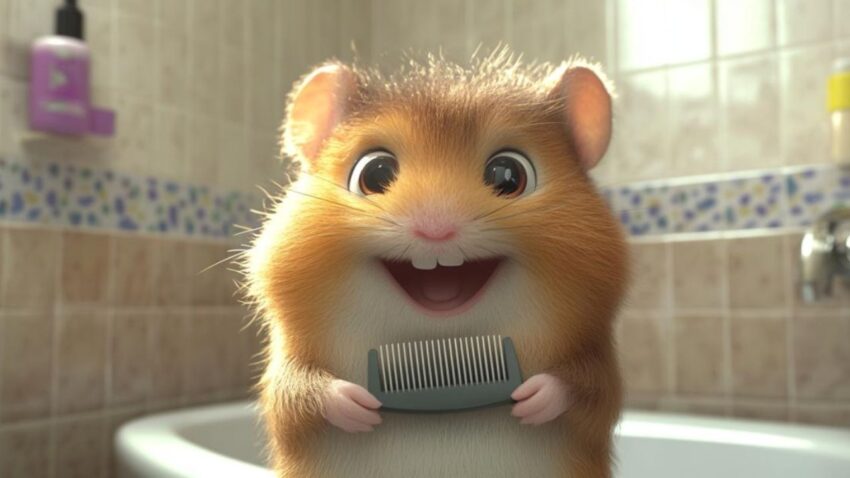Hello there, my dear hamster-loving friends! It’s Granny SnuggleSnacks here, ready to chat about something that might not always be top of mind but is oh-so-important—hamster coat care. Our little furry friends may be small, but they have a lot of personality packed into those tiny bodies, and their coats are an important part of their overall health and well-being. Just like how we feel better after a good hair day, our hamsters thrive when their coats are clean, soft, and well-maintained.
You might be wondering why coat care is so important for a creature that’s so good at grooming itself. Well, my darlings, while hamsters are pretty good at keeping themselves tidy, they sometimes need a little extra help from us to ensure their coats stay in tip-top shape. From understanding the different types of hamster coats to spotting common coat issues, a little knowledge goes a long way in keeping your hamster looking and feeling their best.
So, let’s dive in and talk about why coat care matters, the different types of hamster coats, and some common coat issues to keep an eye on.
Why Coat Care Matters
Now, you might be thinking, “Granny, why should I fuss over my hamster’s coat? They seem to do just fine on their own!” And you’re right—hamsters are naturally tidy little creatures. They spend a good chunk of their time grooming themselves, making sure their fur is clean and in order. However, just like how we occasionally need a little extra pampering with a haircut or a deep conditioning treatment, our hamsters sometimes need a bit of assistance to keep their coats in the best condition possible.
A well-maintained coat isn’t just about looks (though, who doesn’t love a soft, shiny coat?). It’s also a crucial aspect of your hamster’s health. A clean, well-groomed coat can prevent a host of issues, such as matting, skin irritations, and even parasites. Additionally, grooming provides an excellent opportunity for you to bond with your hamster and check for any unusual lumps, bumps, or signs of illness.
In short, good coat care helps your hamster stay comfortable, healthy, and happy. And when your hamster is happy, you’ll notice they’re more active, playful, and, well, just more themselves!
Understanding Different Hamster Coats
Not all hamster coats are created equal, my dears! Depending on the breed of your hamster, they could have a short coat, a long coat, or something in between. Understanding the type of coat your hamster has will help you tailor your grooming routine to their specific needs.
- Short-Coated Hamsters: The most common type of hamster coat is short and sleek. This type of coat is relatively low-maintenance, but that doesn’t mean it doesn’t require attention. Short-coated hamsters, like the popular Syrian hamster, still benefit from occasional brushing to remove loose fur and keep their coat shiny.
- Long-Coated Hamsters: Long-haired hamsters, often referred to as “Teddy Bear” hamsters, have luxurious, flowing fur that can be a sight to behold. However, with great beauty comes great responsibility! These hamsters are more prone to tangles and mats, especially around the belly and behind the ears, so regular brushing is a must to keep their fur looking its best.
- Rex-Coated Hamsters: Rex hamsters have a unique coat that is curly and slightly coarser than other types. This curly fur can be more prone to collecting debris and might require more frequent grooming to keep it clean and tidy. The good news is that their coat is less likely to mat than a long-haired hamster’s.
- Satin-Coated Hamsters: Satin hamsters have a beautiful, shiny coat that almost looks like it’s been polished. While stunning to look at, satin coats can sometimes be a bit finer and more prone to thinning, so gentle grooming is essential to avoid damaging their delicate fur.
Understanding your hamster’s coat type will help you determine how often you should groom them and what tools you might need to keep their coat in perfect condition. And remember, every hamster is different—what works for one might not work for another, so always pay attention to your hamster’s specific needs.
Common Coat Issues to Watch For
Even with the best care, sometimes our hamsters can develop issues with their coats. Knowing what to look for can help you catch any problems early and address them before they become serious.
Here are some common coat issues to keep an eye on:
- Mats and Tangles: These are more common in long-haired hamsters, but even short-haired breeds can occasionally develop mats if they get something sticky or dirty in their fur. Regular brushing can help prevent mats, but if you do find one, it’s important to gently work it out with a fine-toothed comb or, in severe cases, carefully trim it away.
- Dull or Thinning Fur: If your hamster’s coat starts to look dull, thin, or patchy, it could be a sign of a nutritional deficiency or an underlying health issue. Sometimes, a simple diet adjustment can make all the difference, but it’s always a good idea to consult with a vet if you notice significant changes in your hamster’s fur.
- Excessive Shedding: While all hamsters shed a little, especially during seasonal changes, excessive shedding can be a sign of stress, illness, or an issue with their diet. If your hamster is shedding more than usual, take a closer look at their environment and food, and consider a vet visit if the shedding continues.
- Skin Irritations or Parasites: Red, flaky skin, bald patches, or constant scratching can indicate skin irritation or the presence of parasites like mites or lice. If you notice any of these signs, it’s crucial to consult a vet as soon as possible to get your hamster the treatment they need.
By being aware of these common coat issues and staying on top of your hamster’s grooming routine, you can help prevent small problems from turning into bigger ones. After all, a little bit of care and attention can go a long way in keeping your hamster’s coat—and their overall health—in the best possible condition.
Regular Grooming Routine

Hello again, my wonderful hamster caretakers! Now that we’ve talked about why coat care is so important and the different types of coats your little fluffballs might have, it’s time to dive into establishing a regular grooming routine. Just like us, hamsters thrive on consistency and routine, and having a set grooming schedule can make all the difference in keeping your hamster’s coat healthy and beautiful. Let me walk you through the essentials of a regular grooming routine, from brushing to bathing (which, as you’ll soon see, is not as frequent as you might think) and keeping those tiny claws in tip-top shape.
Brushing Basics: Tools and Techniques
Brushing your hamster might sound like a daunting task, but with the right tools and a gentle touch, it can be a pleasant experience for both you and your furry friend. Regular brushing helps remove loose fur, prevents matting, and keeps your hamster’s coat shiny and smooth. Here’s how to get started:
Choosing the Right Brush
First things first, you’ll need to select the appropriate brush for your hamster’s coat type. For short-coated hamsters, a soft-bristled toothbrush or a small, fine-toothed comb works wonderfully. Long-coated breeds, like the Teddy Bear hamster, benefit from a slicker brush or a wide-toothed comb to gently detangle their luxurious fur without causing discomfort.
Brushing Technique
When it’s time to brush, make sure your hamster is calm and comfortable. It’s best to groom them in a quiet, stress-free environment. Gently hold your hamster in your lap or on a soft surface, and start by softly stroking their back in the direction of hair growth. Use gentle, short strokes to avoid pulling on their delicate fur. Pay special attention to areas prone to matting, such as the belly and behind the ears. If you encounter any tangles, patiently work them out with a comb, being careful not to tug too hard.
Frequency of Brushing
How often you brush your hamster depends on their coat type and individual needs. Short-coated hamsters generally only need brushing once a week to remove loose fur and keep their coat shiny. Long-coated hamsters may require brushing two to three times a week to prevent tangles and mats. Always observe your hamster’s coat and adjust the frequency as needed—some hamsters may enjoy brushing more often, while others might prefer it less frequently.
Bathing: When and How (Hint: Rarely!)
Now, let’s address the big question: should you bathe your hamster? The short answer is, usually, no! Hamsters are naturally clean animals and take great care of their own grooming needs. Bathing them can sometimes do more harm than good, so it’s important to know when and how to give your hamster a bath, and why it’s rarely necessary.
When to Bathe Your Hamster
In most cases, your hamster won’t need a bath. However, there are a few exceptions:
- Messy Accidents: If your hamster gets something sticky or particularly messy in their fur, a bath might be necessary to clean them up.
- Oily or Dirty Coat: If your hamster’s coat looks unusually oily or dirty despite regular brushing, a bath might help.
- Medical Reasons: Sometimes, a vet may recommend a bath for specific skin conditions or other health issues.
How to Bathe Your Hamster
If a bath is truly necessary, here’s how to do it safely:
- Use the Right Water Temperature: Fill a shallow container with lukewarm water—make sure it’s not too hot or too cold.
- Gentle Introduction: Gently place your hamster in the water and let them splash around for no more than a minute. Hamsters can become stressed easily, so keep the bath short and soothing.
- Rinse Thoroughly: After the bath, gently rinse your hamster with clean, lukewarm water to remove any soap residue.
- Drying Off: Carefully dry your hamster with a soft towel. Make sure they are completely dry before returning them to their cage to prevent them from getting chilled.
Alternatives to Bathing
Instead of bathing, consider these alternatives to keep your hamster clean:
- Sand Baths: Provide a shallow dish filled with chinchilla sand. Hamsters love rolling around in the sand, which helps absorb excess oils and keeps their coat clean.
- Spot Cleaning: Use a damp cloth or cotton ball to gently wipe any dirty areas without fully submerging your hamster in water.
Keeping Claws in Check
While grooming your hamster’s coat is essential, don’t forget about their claws! Keeping your hamster’s claws trimmed is an important part of their overall care, ensuring they can move around comfortably and preventing any accidental scratches.
How to Trim Claws Safely
Trimming your hamster’s claws requires a gentle touch and the right tools. Here’s how to do it safely:
- Gather Your Supplies: You’ll need a pair of small, pet-safe nail clippers or scissors, some styptic powder (in case of accidental bleeding), and treats to reward your hamster for their cooperation.
- Calm Environment: Choose a quiet time to trim their claws, when your hamster is calm and relaxed. You might want to do this after a grooming session when they’re already handled.
- Handling Your Hamster: Gently hold your hamster in your lap or on a soft surface, making sure they feel secure. Carefully examine their claws and identify the quick (a small pink area inside the nail) to avoid cutting it.
- Trimming Technique: Trim just the sharp tip of each claw, being careful not to cut into the quick. If you accidentally trim the quick and it starts to bleed, apply a small amount of styptic powder to stop the bleeding.
- Positive Reinforcement: After trimming, give your hamster a treat and some gentle praise to make the experience positive.
Frequency of Claw Trimming
How often you need to trim your hamster’s claws depends on their activity level and the surfaces they live on. Hamsters that have plenty of opportunities to wear down their claws naturally may require less frequent trimming, perhaps every few weeks. Others might need their claws trimmed monthly to prevent them from becoming overgrown and causing discomfort or injury.
Signs Your Hamster Needs a Claw Trim
Keep an eye out for these signs that your hamster’s claws might be too long:
- Clicking Sounds: Hearing clicking sounds when your hamster walks on hard surfaces indicates that their claws are too long and hitting the cage floor.
- Difficulty Walking: Overgrown claws can make it hard for your hamster to move around comfortably.
- Snagging or Breaking: If you notice claws snagging on bedding or breaking easily, it’s time for a trim.
By incorporating regular grooming, occasional bathing when necessary, and keeping those tiny claws in check, you’re ensuring that your hamster remains comfortable, healthy, and looking their very best. Remember, a well-groomed hamster is a happy hamster, and your loving care will shine through in their beautiful, shiny coat!
Seasonal Coat Care

Hello again, my lovely hamster enthusiasts! Now that we’ve covered the basics of grooming and keeping those tiny claws in check, it’s time to talk about how the changing seasons can affect your hamster’s coat. Just like us, our furry friends go through seasonal changes that can influence their fur and skin. With a little extra care tailored to the season, you can help your hamster stay comfortable and maintain a healthy, beautiful coat all year long.
Let’s explore what to expect during shedding season, how to deal with dry winter skin, and some useful tips for keeping your hamster cool and clean during the summer months.
Shedding Season: What to Expect
Ah, shedding season! It’s a time when you might notice a little more fur around your hamster’s cage or even on your clothes after a cuddle session. Don’t worry, though—shedding is a completely natural process for hamsters, and it’s their way of getting rid of old, dead fur to make room for new growth. Understanding what to expect during shedding season can help you manage the extra fur and keep your hamster’s coat looking fabulous.
When Does Shedding Occur?
Hamsters typically shed twice a year, during the spring and fall, as they transition between their summer and winter coats. In the spring, they shed their thicker winter fur to prepare for warmer weather, while in the fall, they shed their lighter summer coat to make way for a thicker, insulating coat for the cold months ahead. This seasonal shedding is usually more noticeable in long-haired hamsters, but even short-haired breeds will experience it to some degree.
How to Manage Shedding
Here are some tips to help you and your hamster get through shedding season with minimal fuss:
- Increase Brushing Frequency: During shedding season, brushing your hamster’s coat more frequently can help remove loose fur before it ends up all over their cage—or your home! For short-haired hamsters, brushing two to three times a week should suffice. Long-haired hamsters may benefit from daily brushing to prevent tangles and mats.
- Use the Right Tools: A soft-bristled brush or a fine-toothed comb works well for short-haired hamsters, while a slicker brush or wide-toothed comb is ideal for long-haired breeds. Regular brushing not only helps manage shedding but also stimulates the skin and promotes healthy fur growth.
- Keep the Cage Clean: With all that extra fur floating around, it’s important to keep your hamster’s cage clean. Regularly spot-clean the cage and change the bedding to remove any shed fur. This will help prevent fur from getting tangled in the bedding and keep your hamster’s living environment fresh.
- Monitor for Bald Spots: While some shedding is normal, be on the lookout for any bald spots or excessive hair loss. If you notice areas where your hamster’s fur is thinning or if the shedding seems more extreme than usual, it could be a sign of stress, illness, or a nutritional deficiency. In such cases, a visit to the vet is a good idea to rule out any underlying issues.
Dealing with Dry Winter Skin
Winter can be tough on everyone’s skin—including your hamster’s! The cold, dry air of winter can lead to dry, flaky skin, which can make your hamster uncomfortable and itchy. Fortunately, there are a few simple steps you can take to help keep your hamster’s skin moisturized and their coat soft and healthy during the colder months.
Signs of Dry Winter Skin
Dry skin in hamsters can manifest as flaky patches, excessive scratching, or dull fur. You might notice small flakes of skin in their fur or on their bedding, similar to dandruff. If your hamster seems unusually itchy or is scratching more than usual, it could be a sign that the dry winter air is affecting their skin.
How to Moisturize and Protect Your Hamster’s Skin
Here’s how to help your hamster maintain healthy skin and fur during the winter:
- Humidify the Air: Dry indoor air can contribute to dry skin, so consider using a humidifier in the room where your hamster’s cage is located. This can help maintain a healthier level of humidity, which in turn can keep your hamster’s skin from becoming too dry.
- Add Omega-3s to Their Diet: Omega-3 fatty acids are great for skin health, and adding a small amount to your hamster’s diet can help keep their skin moisturized from the inside out. You can introduce omega-3s through flaxseeds or a tiny bit of flaxseed oil mixed into their food. Be sure to consult your vet before making any significant changes to your hamster’s diet.
- Avoid Overbathing: While we’ve already talked about how hamsters rarely need baths, this is especially important in winter. Bathing can strip the natural oils from your hamster’s skin, making it even drier. Stick to sand baths and spot cleaning to keep your hamster clean without drying out their skin.
- Cage Location: Make sure your hamster’s cage isn’t placed too close to heaters or vents, as the hot air can dry out their skin. Instead, position the cage in a draft-free area where the temperature is stable and comfortable.
- Moisturizing Sprays: If your hamster’s skin is particularly dry, you can use a pet-safe moisturizing spray, but this should be done cautiously and only under the guidance of a vet. Hamsters have sensitive skin, and not all products are safe for them, so always choose a product specifically designed for small animals.
Summer Tips: Staying Cool and Clean
Summer brings its own set of challenges for hamster care, particularly when it comes to keeping your hamster cool and comfortable. Hamsters can easily overheat, so it’s important to take steps to ensure they stay cool, clean, and hydrated during the warmer months.
Signs of Overheating
Hamsters are highly sensitive to heat and can quickly become overheated in high temperatures. Signs that your hamster may be too hot include:
- Panting or Rapid Breathing: If your hamster is breathing rapidly or panting, it’s a sign they’re struggling with the heat.
- Lethargy: A hamster that is unusually lethargic or less active than normal might be overheated.
- Flattening Out: Hamsters sometimes flatten their bodies against the cool surface of their cage to try and cool down. This behavior can indicate that they’re too warm.
If you notice any of these signs, take immediate steps to cool your hamster down, such as moving their cage to a cooler location and providing fresh water.
Keeping Your Hamster Cool
Here are some tips to help your hamster stay cool during the summer:
- Cage Location: Place your hamster’s cage in a cool, shaded area of your home, away from direct sunlight and heat sources. A room with good ventilation and a fan (not blowing directly on the cage) can help keep the temperature down.
- Cooling Accessories: Provide your hamster with a ceramic tile or a smooth, flat stone to lie on. These materials stay cooler than plastic or bedding, giving your hamster a refreshing spot to rest. You can even place the tile in the fridge for a few minutes to make it extra cool.
- Fresh Water: Make sure your hamster always has access to fresh, cool water. Check their water bottle regularly to ensure it’s full and functioning properly. On particularly hot days, consider adding an extra water bottle just in case.
- Frozen Treats: Offer your hamster a cool, hydrating treat, like a small piece of cucumber or watermelon. You can also freeze tiny portions of these fruits to create a refreshing snack, but be sure to give them in moderation due to their high water content.
Summer Grooming Tips
In addition to keeping your hamster cool, summer is also a good time to pay extra attention to their grooming needs:
- Brushing: Continue to brush your hamster regularly to remove loose fur, especially during the summer shedding period. Brushing helps keep your hamster cool by preventing their fur from becoming too thick or matted.
- Sand Baths: Sand baths are a great way for your hamster to stay clean and cool in the summer. The sand helps remove excess oils from their fur and gives them a fun way to cool down. Be sure to use chinchilla sand, not dust, as the dust can cause respiratory issues.
- Spot Cleaning: If your hamster gets sweaty or dirty, use a damp cloth to gently clean them rather than giving them a full bath. This helps keep their coat fresh without the stress of water.
By tailoring your hamster’s coat care to the changing seasons, you can help them stay comfortable, healthy, and happy no matter what the weather is like outside. Whether it’s managing shedding in the spring and fall, combating dry skin in the winter, or keeping your hamster cool in the summer, a little extra care goes a long way in maintaining a beautiful, well-groomed coat all year round.
Diet and Its Impact on Coat Health

Hello again, my wonderful hamster caretakers! We’ve talked about grooming routines and seasonal coat care, but now it’s time to focus on something that plays a huge role in your hamster’s overall health, including their coat—diet! Just like us, hamsters need a balanced, nutritious diet to keep their fur looking shiny and their skin healthy. What your little furball eats doesn’t just affect their energy levels or growth; it also has a significant impact on the quality of their coat. By understanding the essential nutrients that contribute to a beautiful, healthy coat and knowing what foods to avoid, you can help your hamster maintain their silky, shiny fur. Plus, I’ll let you in on the secret of omega-3s, a wonderful supplement that can work wonders for coat health.
So, let’s dig into the details of how your hamster’s diet affects their coat and what you can do to ensure they’re getting everything they need for a glowing, healthy appearance!
Essential Nutrients for a Shiny Coat
A healthy, shiny coat is a sign that your hamster is getting all the nutrients they need from their diet. Just like how certain vitamins and minerals make our hair stronger and shinier, the same goes for hamsters. Here are the key nutrients that play a crucial role in maintaining a beautiful coat:
Protein
Protein is the building block of life, and it’s especially important for maintaining a healthy coat. Your hamster’s fur is made of keratin, a type of protein, so it’s essential that their diet includes enough high-quality protein to support fur growth and repair.
- Sources of Protein: Make sure your hamster’s diet includes sources of protein like seeds, grains, and nuts, which are typically found in high-quality hamster mixes. You can also supplement with small amounts of cooked egg, plain chicken, or mealworms for an extra protein boost. Remember, though, moderation is key to avoid overfeeding.
Vitamins
Vitamins are vital for your hamster’s overall health, and certain vitamins are particularly important for coat and skin health:
- Vitamin A: This vitamin is essential for healthy skin and fur. It helps produce sebum, a natural oil that keeps the skin and fur moisturized. Carrots, sweet potatoes, and spinach are great sources of vitamin A.
- Vitamin E: Known for its antioxidant properties, vitamin E protects skin cells from damage and supports healthy fur growth. It’s found in leafy greens, seeds, and nuts.
- B Vitamins: B vitamins, especially biotin (vitamin B7), are crucial for maintaining a healthy coat. They help metabolize fats and proteins, which are essential for fur growth. Grains, eggs, and leafy greens are good sources of B vitamins.
Fats and Omega-3 Fatty Acids
Fats are another essential component of a healthy diet that directly impacts coat health. Omega-3 fatty acids, in particular, are known for their role in promoting shiny, soft fur.
- Healthy Fats: A small amount of healthy fats in your hamster’s diet helps keep their fur soft and shiny. These fats are found in seeds (like sunflower seeds), nuts, and certain grains.
- Omega-3 Fatty Acids: We’ll delve more into omega-3s in a moment, but suffice it to say that these fatty acids are a wonder for coat health, helping to reduce inflammation, keep the skin healthy, and promote a glossy coat.
Minerals
Minerals like zinc and copper are also important for coat health. They help with the production of keratin and support overall skin and fur health.
- Zinc: Found in grains, seeds, and nuts, zinc helps with cell growth and repair, which is crucial for a healthy coat.
- Copper: This mineral aids in the production of melanin, which gives your hamster’s coat its color. It’s found in nuts, seeds, and grains.
Ensuring your hamster gets a diet rich in these essential nutrients will help them maintain a shiny, healthy coat that reflects their overall good health.
Foods to Avoid for Healthy Fur
Just as there are foods that benefit your hamster’s coat, there are also some that can have the opposite effect. Feeding your hamster the wrong foods can lead to dull, greasy, or even thinning fur. Here’s a list of foods to avoid if you want to keep your hamster’s coat in top condition:
Sugary Foods
Sugar can have a negative impact on your hamster’s skin and fur, much like it does for us humans. Too much sugar can lead to obesity, diabetes, and poor coat quality. Sugary treats, fruits high in sugar, or any processed foods should be given sparingly, if at all.
- Limit Fruits: While small amounts of fruits like apple or pear are fine as occasional treats, fruits high in sugar, such as grapes or bananas, should be limited. Excess sugar can contribute to poor skin and fur health.
Fatty and Oily Foods
While healthy fats are good, too much fat or the wrong kinds of fat can make your hamster’s coat greasy and unkempt. Avoid feeding your hamster foods that are too fatty or oily.
- Avoid Processed Human Foods: Foods like chips, cookies, or anything fried should be strictly off-limits. These foods are not only bad for your hamster’s overall health but can also lead to greasy fur and skin issues.
- Limit Nuts and Seeds: Nuts and seeds are healthy in moderation, but they’re also high in fat. Overfeeding these can lead to an oily coat and potential weight gain. Stick to small portions to keep your hamster’s coat shiny without being greasy.
Dairy Products
Dairy can be difficult for hamsters to digest, leading to digestive issues and poor coat quality. While a tiny bit of cheese might be an occasional treat, it’s best to avoid dairy products as a regular part of their diet.
- Cheese in Moderation: If you do offer cheese, it should be in very tiny amounts and only as an occasional treat. Too much dairy can lead to an upset stomach, which can indirectly affect coat health.
- Avoid Milk and Yogurt: Milk and yogurt should generally be avoided, as they can cause digestive upset and don’t contribute to a healthy coat.
By steering clear of these foods, you can help ensure that your hamster’s fur remains healthy, shiny, and free from greasiness or other issues.
Supplementing with Omega-3s
Now, let’s talk about one of the best-kept secrets for maintaining a shiny, healthy coat in hamsters—omega-3 fatty acids! Omega-3s are essential fatty acids that play a crucial role in skin health, reducing inflammation, and promoting a glossy coat. While hamsters can get some omega-3s from their regular diet, supplementing with additional sources can make a noticeable difference in their coat quality.
Benefits of Omega-3s for Hamsters
Omega-3 fatty acids are known for their anti-inflammatory properties, which can help keep your hamster’s skin healthy and reduce the risk of conditions that can lead to dull or thinning fur. Here are some specific benefits:
- Reduces Dry Skin: Omega-3s help keep the skin moisturized from the inside out, which can be especially helpful during the dry winter months.
- Promotes a Shiny Coat: These fatty acids contribute to a glossy, soft coat by nourishing the skin and supporting healthy fur growth.
- Supports Overall Health: Beyond just coat health, omega-3s are beneficial for your hamster’s overall well-being, including heart health and cognitive function.
How to Supplement Omega-3s Safely
There are a few ways to safely introduce omega-3s into your hamster’s diet:
- Flaxseeds: Flaxseeds are an excellent source of omega-3s and are easy to add to your hamster’s diet. Just sprinkle a small pinch of ground flaxseeds onto their food a couple of times a week. Be careful not to overdo it, as flaxseeds are also high in fat.
- Flaxseed Oil: A tiny drop of flaxseed oil mixed into their food once a week can also provide a good boost of omega-3s. Again, moderation is key to avoid adding too much fat to their diet.
- Fish Oil: While less commonly used for hamsters, fish oil is another source of omega-3s. If you’re considering fish oil, consult your vet first to ensure it’s appropriate for your hamster and to determine the correct dosage.
Monitoring and Adjusting
As with any dietary supplement, it’s important to monitor your hamster for any changes or adverse reactions when you first introduce omega-3s. Start with small amounts and observe how your hamster’s coat and overall health respond. If you notice positive changes, you can continue supplementing as part of their regular diet.
However, if your hamster’s coat becomes greasy or if they start gaining weight, you may need to reduce the amount of omega-3s you’re providing. Each hamster is unique, so it may take a bit of trial and error to find the right balance.
Handling Common Coat Problems

Hello again, my dear hamster lovers! We’ve talked about how to maintain a shiny, healthy coat through proper grooming and diet, but what happens when problems arise? Even with the best care, our little furballs can sometimes develop issues with their coats. From tangles and mats to pesky parasites, knowing how to handle these common coat problems is key to keeping your hamster happy and comfortable. And, of course, we’ll also discuss the warning signs that indicate it might be time for a visit to the vet.
Let’s dive into the details of preventing and treating tangles and mats, managing parasites like mites and lice, and knowing when your hamster’s coat issues require professional attention.
Tangles and Mats: Prevention and Treatment
Tangles and mats are a common issue, especially for hamsters with long or thick fur. Left untreated, these can become uncomfortable for your hamster, leading to skin irritation or even infection. The good news is that with regular grooming and a little know-how, you can easily prevent and treat tangles and mats.
Prevention of Tangles and Mats
As the saying goes, an ounce of prevention is worth a pound of cure! Here’s how to prevent tangles and mats from forming in your hamster’s fur:
- Regular Brushing: The best way to prevent tangles and mats is through regular brushing. For short-haired hamsters, brushing once a week is usually enough. For long-haired hamsters, aim for two to three times a week, or even daily if their fur is prone to tangling. Use a soft-bristled brush or a wide-toothed comb to gently detangle their fur.
- Keep Bedding Clean: Dirty or clumpy bedding can contribute to tangling, especially if it sticks to your hamster’s fur. Regularly clean and replace your hamster’s bedding to prevent debris from getting caught in their coat.
- Check for Debris: Regularly inspect your hamster’s coat for any foreign objects like hay, bedding, or food that might get tangled in their fur. Gently remove any debris you find to prevent it from turning into a mat.
- Consider a Trim: If your hamster has long fur that tends to tangle easily, consider giving them a light trim, especially around the areas that are most prone to mats, like the belly and behind the ears. Use small, blunt scissors, and always be extremely careful to avoid cutting the skin.
Treating Tangles and Mats
If you do find a tangle or mat in your hamster’s fur, don’t panic—here’s how to handle it:
- Gently Work It Out: Start by trying to gently work out the tangle with your fingers. If that doesn’t work, use a fine-toothed comb to carefully detangle the fur. Always be gentle, as pulling too hard can hurt your hamster or damage their fur.
- Use a Detangler: For stubborn mats, you can use a small amount of pet-safe detangling spray. Spray a tiny bit onto the mat and gently work it through with your fingers or a comb. Be sure to choose a product specifically designed for small animals, as products meant for other pets can be too harsh.
- Trim if Necessary: If the mat is too tight to be detangled, you may need to carefully trim it out. Use small, blunt-tipped scissors and gently cut the mat out, being careful not to cut the skin. If you’re not comfortable doing this yourself, it’s always best to ask your vet or a professional groomer for help.
- Prevent Future Mats: Once the mat is removed, make sure to brush your hamster more frequently to prevent future tangles and mats from forming.
Managing Parasites: Mites and Lice
No one likes to think about parasites, but unfortunately, mites and lice can sometimes make themselves at home in your hamster’s fur. These tiny pests can cause a range of problems, from itching and irritation to more serious skin conditions. The good news is that with prompt treatment, you can get rid of these pesky invaders and keep your hamster comfortable.
Recognizing Mites and Lice
Before you can treat parasites, you need to know what you’re dealing with. Here’s how to recognize mites and lice in your hamster’s fur:
- Mites: Mites are tiny, spider-like creatures that can cause intense itching, hair loss, and scabs. You might notice your hamster scratching more than usual, or see red, irritated skin. Mites are often too small to see with the naked eye, but their effects are noticeable. In severe cases, you might spot tiny moving dots on your hamster’s skin.
- Lice: Lice are small, wingless insects that attach to the hair shafts and skin, causing itching and discomfort. You might see tiny white or brown specks in your hamster’s fur, particularly around the neck and shoulders. Lice are usually easier to see than mites, especially if you part your hamster’s fur and look closely.
Treating Mites and Lice
If you suspect your hamster has mites or lice, it’s important to act quickly to prevent the infestation from getting worse:
- Visit the Vet: The first step in treating mites or lice is to take your hamster to the vet for a proper diagnosis. Your vet can confirm the presence of parasites and recommend the best treatment, which might include medicated shampoos, sprays, or oral medications.
- Clean the Cage Thoroughly: While treating your hamster, it’s essential to thoroughly clean and disinfect their cage, bedding, and any toys or accessories. Parasites can live in the environment, so cleaning helps prevent reinfestation. Replace all bedding and clean the cage with hot water and a pet-safe disinfectant.
- Quarantine if Necessary: If you have multiple hamsters, you may need to quarantine the affected hamster to prevent the parasites from spreading. Keep them in a separate cage and monitor your other pets closely for signs of infestation.
- Follow the Treatment Plan: Be diligent in following your vet’s treatment plan, which might include multiple treatments over several weeks to fully eliminate the parasites. Never use over-the-counter treatments designed for other animals without consulting your vet, as these can be harmful to hamsters.
- Monitor for Recurrence: After treatment, keep a close eye on your hamster for any signs of recurrence, such as itching or hair loss. If the problem persists, return to the vet for further evaluation.
When to See a Vet: Warning Signs in Your Hamster’s Fur
Sometimes, no matter how well you care for your hamster, issues can arise that require professional attention. Knowing when to take your hamster to the vet is crucial for catching problems early and ensuring they get the care they need.
Warning Signs to Watch For
Here are some signs in your hamster’s fur and skin that indicate it’s time for a vet visit:
- Excessive Shedding or Bald Spots: While shedding is normal, excessive hair loss or bald spots are not. These could indicate stress, nutritional deficiencies, hormonal imbalances, or underlying skin conditions that need veterinary attention.
- Red, Inflamed Skin: Red, inflamed skin can be a sign of irritation, infection, or an allergic reaction. If your hamster’s skin looks sore, swollen, or is accompanied by excessive scratching, it’s time to consult your vet.
- Scabs or Open Sores: Scabs or open sores on your hamster’s skin can result from scratching, mites, or bacterial infections. These wounds can quickly become infected, so it’s important to seek veterinary care promptly.
- Greasy, Dull, or Unkempt Fur: If your hamster’s fur suddenly becomes greasy, dull, or unkempt, it could be a sign of an underlying health issue. This might be due to dietary imbalances, stress, or illness, and your vet can help determine the cause.
- Behavioral Changes: Any significant change in your hamster’s behavior, such as lethargy, decreased grooming, or irritability, can indicate a health problem. Often, these behavioral changes are accompanied by visible issues in their fur or skin.
What to Expect at the Vet
When you take your hamster to the vet for coat-related issues, here’s what you can expect:
- Physical Examination: Your vet will perform a thorough physical examination, checking your hamster’s skin, fur, and overall condition. They may use a magnifying glass or special light to look for parasites or signs of skin infections.
- Skin Scraping or Fur Samples: If parasites or infections are suspected, your vet might take a skin scraping or fur sample to examine under a microscope. This helps them identify the exact cause of the problem.
- Treatment Plan: Based on their findings, your vet will recommend a treatment plan. This could include topical treatments, oral medications, changes to diet, or advice on environmental adjustments to improve your hamster’s condition.
- Follow-Up Care: Your vet may schedule a follow-up visit to monitor your hamster’s progress and ensure the treatment is effective. Be sure to follow their instructions closely and report any changes or concerns during the treatment period.
By staying vigilant and knowing when to seek veterinary care, you can catch potential coat problems early and ensure your hamster gets the help they need to stay healthy and comfortable.
Conclusion: Keeping Your Hamster’s Coat Glowing

Well, my dear hamster-loving friends, we’ve reached the end of our furry little journey through the world of hamster coat care! From understanding the importance of diet and grooming to tackling seasonal challenges and dealing with common coat problems, we’ve covered all the essentials you need to keep your hamster’s coat in tip-top shape. A shiny, healthy coat is more than just a sign of good looks—it’s a reflection of your hamster’s overall well-being. With a little bit of love, care, and attention, you can ensure that your hammy is always glowing, inside and out.
Let’s wrap things up with a quick recap of the key grooming tips we’ve discussed, the importance of routine vet check-ups, and some final SnuggleTips to keep your hamster happy, healthy, and beautiful all year round.
Recap of Key Grooming Tips
First, let’s revisit some of the most important grooming tips that will help you maintain your hamster’s coat and keep it looking fabulous:
- Regular Brushing: Brushing is the cornerstone of a good grooming routine. For short-haired hamsters, a weekly brushing session with a soft-bristled brush or fine-toothed comb is usually enough to keep their fur smooth and shiny. Long-haired hamsters, on the other hand, may need brushing two to three times a week—or even daily—to prevent tangles and mats. Brushing not only helps remove loose fur but also stimulates the skin and distributes natural oils, which are essential for a healthy coat.
- Bathing Sparingly: Remember, hamsters are naturally clean animals and rarely need a full bath. Overbathing can strip their fur of essential oils, leading to dry skin and a dull coat. Instead, offer your hamster a sand bath, which helps them keep their fur clean and free of excess oils. If your hamster gets into something messy, a spot clean with a damp cloth is usually all that’s needed.
- Trimming Claws Carefully: Overgrown claws can cause discomfort and lead to scratches or injuries. Check your hamster’s claws regularly, and trim them carefully using small, pet-safe nail clippers. If you’re unsure or uncomfortable doing it yourself, don’t hesitate to ask your vet for help.
- Seasonal Adjustments: Just like us, hamsters’ grooming needs can change with the seasons. In the spring and fall, be prepared for shedding and increase your brushing frequency to help manage loose fur. In winter, be on the lookout for dry skin, and in summer, take steps to keep your hamster cool and hydrated.
- Diet Matters: Don’t forget that a shiny coat starts from the inside out. A balanced diet rich in protein, vitamins, and healthy fats is essential for maintaining a healthy coat. Consider supplementing with omega-3s for that extra boost of shine, and always provide fresh water and a variety of nutritious foods.
The Role of Routine Check-ups
While regular grooming and a good diet are crucial, routine vet check-ups play an equally important role in keeping your hamster’s coat (and overall health) in top condition. Here’s why those check-ups are so vital:
- Early Detection of Issues: Regular vet visits allow for early detection of potential health issues that might not be immediately visible. Your vet can catch problems like parasites, skin infections, or nutritional deficiencies before they become more serious.
- Expert Advice: Your vet is a valuable resource when it comes to your hamster’s health. They can provide tailored advice on diet, grooming, and any specific care needs your hamster might have based on their breed, age, and overall condition.
- Peace of Mind: Knowing that your hamster is in good health gives you peace of mind. Routine check-ups ensure that you’re doing everything you can to provide the best possible care, allowing your hamster to thrive and enjoy life to the fullest.
Aim to take your hamster for a check-up at least once a year, or more frequently if they’re older or have known health issues. And remember, if you notice any changes in your hamster’s coat, behavior, or general well-being, don’t hesitate to schedule an extra visit.
SnuggleTips for a Happy, Healthy, and Beautiful Hammy
Finally, let’s talk about some SnuggleTips—those little extra touches that make all the difference in keeping your hamster happy, healthy, and as beautiful as can be:
- Create a Calm Grooming Environment: Grooming time should be a calm and enjoyable experience for both you and your hamster. Choose a quiet, stress-free environment, and handle your hamster gently. Talk to them in a soothing voice, and reward them with a treat after each grooming session to reinforce positive associations.
- Observe and Adapt: Every hamster is unique, so it’s important to observe your hamster’s individual needs and adapt your care routine accordingly. Pay attention to how your hamster responds to grooming, changes in their diet, or seasonal shifts, and adjust as needed to keep them comfortable and content.
- Keep Their Living Space Clean: A clean living environment is crucial for maintaining a healthy coat. Regularly clean your hamster’s cage, replace soiled bedding, and make sure their water and food dishes are always fresh. A clean cage reduces the risk of skin infections, parasites, and other issues that can affect your hamster’s coat.
- Provide Enrichment: A happy hamster is a healthy hamster! Make sure your hamster has plenty of opportunities for mental and physical enrichment. Toys, tunnels, wheels, and foraging activities not only keep your hamster entertained but also help reduce stress, which can have a positive impact on their coat and overall health.
- Stay Connected: Don’t forget that you’re not alone in your hamster care journey! Stay connected with other hamster owners, whether through online forums, social media groups, or local pet communities. Sharing tips, experiences, and advice can help you continue learning and improving your hamster care practices.
- Love and Attention: Above all, shower your hamster with love and attention. The bond you share with your hamster is the foundation of their happiness and well-being. Regular interaction, gentle handling, and plenty of affection will help your hamster feel secure and loved, which reflects in their overall health and appearance.
As we wrap up our discussion on hamster coat care, remember that a well-cared-for hamster is a happy, healthy, and beautiful one. By following these grooming tips, ensuring regular vet check-ups, and adding those special SnuggleTips to your routine, you’ll be doing everything you can to keep your hamster’s coat glowing and their little hearts full of joy.




